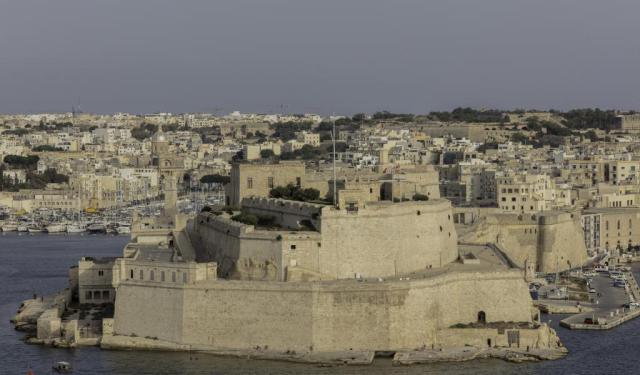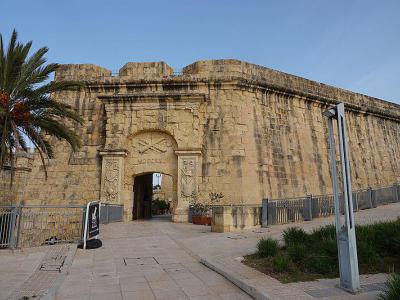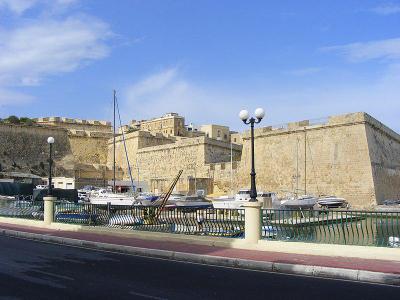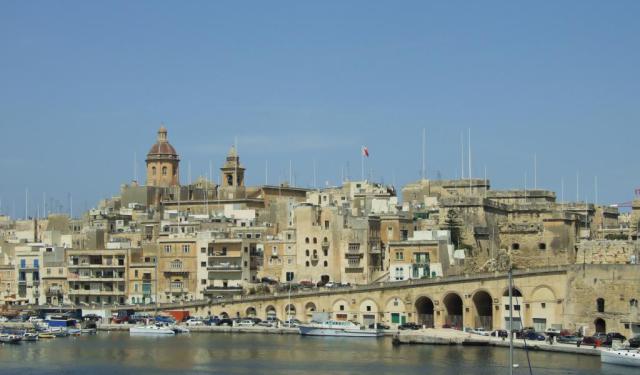
Birgu Fortifications Walking Tour (Self Guided), Birgu
The defensive complex surrounding Birgu, Malta, began to take shape in the early Middle Ages when Fort Saint Angelo was built circa the mid-1200s. The majority of other fortifications here were erected between the 16th and 18th centuries under the auspices of the Order of Saint John.
Remarkably, a significant portion of Birgu's fortifications remains well-preserved to this day and have been included in Malta's tentative list of UNESCO World Heritage Sites since 1998, forming a part of the Knights' Fortifications surrounding the harbors of Malta.
One of its notable features is the Notre Dame Gate, a majestic structure that once served as a crucial entrance to the city.
Another remarkable edifice is the Covered Gate (Couvre Porte). This fortification marvel protected the city's inhabitants during sieges, showcasing the strategic genius of its builders.
Saint John Bastion and the Advanced Gate further exemplify the city's formidable protection lines. They formed an integral part of Birgu's defense, with the Advanced Gate acting as a second line of defense.
The Gate of Provence is another key landmark in Birgu's fortifications. Its historical importance lies in its role as a symbolic gateway connecting Malta to the wider Mediterranean world, a testament to the island's strategic position.
The Post of Castile is yet another testament to Birgu's fortitude. This defensive post played a crucial role in safeguarding the city and its inhabitants from various threats over the centuries.
Last but not least, Fort Saint Angelo, overlooking Birgu from across the Grand Harbour, stands as a symbol of Malta's enduring military heritage. This formidable fortress has witnessed centuries of history and played a crucial role in protecting the city from invaders.
The fortifications of Birgu are not just architectural marvels but also symbolize the city's resilience and determination throughout history. Visitors and scholars alike explore these locations to gain a deeper understanding of Malta's heritage. You, too, can do it in your own time with the help of our self-guided tour. Enjoy the exploration!
Remarkably, a significant portion of Birgu's fortifications remains well-preserved to this day and have been included in Malta's tentative list of UNESCO World Heritage Sites since 1998, forming a part of the Knights' Fortifications surrounding the harbors of Malta.
One of its notable features is the Notre Dame Gate, a majestic structure that once served as a crucial entrance to the city.
Another remarkable edifice is the Covered Gate (Couvre Porte). This fortification marvel protected the city's inhabitants during sieges, showcasing the strategic genius of its builders.
Saint John Bastion and the Advanced Gate further exemplify the city's formidable protection lines. They formed an integral part of Birgu's defense, with the Advanced Gate acting as a second line of defense.
The Gate of Provence is another key landmark in Birgu's fortifications. Its historical importance lies in its role as a symbolic gateway connecting Malta to the wider Mediterranean world, a testament to the island's strategic position.
The Post of Castile is yet another testament to Birgu's fortitude. This defensive post played a crucial role in safeguarding the city and its inhabitants from various threats over the centuries.
Last but not least, Fort Saint Angelo, overlooking Birgu from across the Grand Harbour, stands as a symbol of Malta's enduring military heritage. This formidable fortress has witnessed centuries of history and played a crucial role in protecting the city from invaders.
The fortifications of Birgu are not just architectural marvels but also symbolize the city's resilience and determination throughout history. Visitors and scholars alike explore these locations to gain a deeper understanding of Malta's heritage. You, too, can do it in your own time with the help of our self-guided tour. Enjoy the exploration!
How it works: Download the app "GPSmyCity: Walks in 1K+ Cities" from Apple App Store or Google Play Store to your mobile phone or tablet. The app turns your mobile device into a personal tour guide and its built-in GPS navigation functions guide you from one tour stop to next. The app works offline, so no data plan is needed when traveling abroad.
Birgu Fortifications Walking Tour Map
Guide Name: Birgu Fortifications Walking Tour
Guide Location: Malta » Birgu (See other walking tours in Birgu)
Guide Type: Self-guided Walking Tour (Sightseeing)
# of Attractions: 6
Tour Duration: 1 Hour(s)
Travel Distance: 2.6 Km or 1.6 Miles
Author: nataly
Sight(s) Featured in This Guide:
Guide Location: Malta » Birgu (See other walking tours in Birgu)
Guide Type: Self-guided Walking Tour (Sightseeing)
# of Attractions: 6
Tour Duration: 1 Hour(s)
Travel Distance: 2.6 Km or 1.6 Miles
Author: nataly
Sight(s) Featured in This Guide:
- Notre Dame Gate
- Couvre Porte (Covered Gate)
- St. John Bastion and the Advanced Gate
- Gate of Provence
- Post of Castile
- Fort St. Angelo
1) Notre Dame Gate
Constructed in 1675 under the auspices of the Order of Saint John, the grand baroque Notre Dame Gate served as the main gate for the Eastern Provinces and is a remarkable testament to the island's architectural heritage. It remains remarkably intact, boasting unique features that set it apart from other structures in Malta. Rising four stories high, it stands as the tallest edifice in the region, offering visitors breathtaking panoramic views of the island from its rooftop.
The gate complex is comprised of four large bomb-proof casemates, each stacked atop the other and flanking the roadway. These casemates are crowned by a magnificent gatehouse, which originally housed the lifting mechanism for the portcullis gate—an impressive piece of engineering in its time. As one explores this historic building, it becomes evident that it carries the scars of its past. Musket ball indentations are etched into the stone, serving as a poignant reminder of the conflicts and battles that have unfolded here. Additionally, countless graffiti left behind by soldiers from the Order's navy, as well as the French and British, provide glimpses into the gate's varied and colorful history.
Over the years, Notre Dame Gate's purpose evolved. In 1870, the construction of the nearby Cottonera Military Hospital led to the gate assuming a new role as an adjunct to the medical establishment. During the Great War, following the Gallipoli campaign's tragic events in 1915, Malta became a critical hub for treating wounded troops. Notre Dame Gate played a part in this effort, accommodating some of the injured soldiers during their treatment and convalescence.
The gate complex is comprised of four large bomb-proof casemates, each stacked atop the other and flanking the roadway. These casemates are crowned by a magnificent gatehouse, which originally housed the lifting mechanism for the portcullis gate—an impressive piece of engineering in its time. As one explores this historic building, it becomes evident that it carries the scars of its past. Musket ball indentations are etched into the stone, serving as a poignant reminder of the conflicts and battles that have unfolded here. Additionally, countless graffiti left behind by soldiers from the Order's navy, as well as the French and British, provide glimpses into the gate's varied and colorful history.
Over the years, Notre Dame Gate's purpose evolved. In 1870, the construction of the nearby Cottonera Military Hospital led to the gate assuming a new role as an adjunct to the medical establishment. During the Great War, following the Gallipoli campaign's tragic events in 1915, Malta became a critical hub for treating wounded troops. Notre Dame Gate played a part in this effort, accommodating some of the injured soldiers during their treatment and convalescence.
2) Couvre Porte (Covered Gate)
The Covered Gate, also known as the Birgu Counterguard, is a historic gateway that provides access to the city of Birgu. Built between 1716 and 1730, it was a strategic addition to the defenses of Birgu. The Gate was constructed by military engineers C.F. de Mondion and L.F. de Tigne during the reign of Grand Master Antoine de Paul (1723-1736). The primary purpose of the Covered Gate was to protect the Porta Superiore, which served as Birgu's main gateway.
The structure has undergone several alterations and additions over the centuries. It features a Baroque gateway that reflects the architectural style of its time. The Covered Gate was enveloped within a new system of outworks, including a covert way with traverses and a reverse glacis.
During the British colonial period, a barrack block was constructed within the counterguard. This building still exists today and has served various purposes, including as the offices for the Birgu Local Council.
The Covered Gate underwent a restoration project, which aimed to preserve its historical fabric. The project involved restoring the masonry, reconstructing the decorative trophies-of-arms on the main gate, and excavating the low ditch. During the excavation, a sally-port, a small hidden exit used for surprise attacks or escapes, was discovered, adding to the historical significance of the site.
Today, the Covered Gate is home to the Malta at War Museum, which is dedicated to showcasing Malta's role in the Second World War.
The museum provides insights into the island's wartime experiences, highlighting its resilience and contributions during this pivotal period in history.
The structure has undergone several alterations and additions over the centuries. It features a Baroque gateway that reflects the architectural style of its time. The Covered Gate was enveloped within a new system of outworks, including a covert way with traverses and a reverse glacis.
During the British colonial period, a barrack block was constructed within the counterguard. This building still exists today and has served various purposes, including as the offices for the Birgu Local Council.
The Covered Gate underwent a restoration project, which aimed to preserve its historical fabric. The project involved restoring the masonry, reconstructing the decorative trophies-of-arms on the main gate, and excavating the low ditch. During the excavation, a sally-port, a small hidden exit used for surprise attacks or escapes, was discovered, adding to the historical significance of the site.
Today, the Covered Gate is home to the Malta at War Museum, which is dedicated to showcasing Malta's role in the Second World War.
The museum provides insights into the island's wartime experiences, highlighting its resilience and contributions during this pivotal period in history.
3) St. John Bastion and the Advanced Gate
Saint John Bastion is a substantial and asymmetrical bastion located within Birgu. It is a notable defensive structure designed by the accomplished military engineer Charles François de Mondion during the 18th century. This bastion features two of the three primary gates of Birgu, which were strategically integrated into its design. A modern road now traverses through an arch within the bastion, serving as a key entry point into the city.
One of the prominent features of Saint John Bastion is the two-tiered structure known as Saint John Cavalier, which originally stood on the bastion until 1565. Subsequently, in the 18th century, modifications were made to the bastion's layout and architecture, with further minor alterations implemented by the British during the 19th century.
Inside the bastion, one can explore its historic walls, courtyards, open spaces, an arched bridge, and a small park. The site also houses a military museum, providing insights into Malta's rich military heritage, along with convenient amenities such as a shop and a snack bar.
The Advanced Gate, located to the right of Saint John's Bastion, serves as the second of the city's three main gates. It plays an integral role in Birgu's fortifications and access points.
The open areas within Saint John Bastion provide visitors with scenic views of the bastion itself, the marina, and the neighboring town of Senglea, offering a glimpse into the historic and picturesque surroundings.
One of the prominent features of Saint John Bastion is the two-tiered structure known as Saint John Cavalier, which originally stood on the bastion until 1565. Subsequently, in the 18th century, modifications were made to the bastion's layout and architecture, with further minor alterations implemented by the British during the 19th century.
Inside the bastion, one can explore its historic walls, courtyards, open spaces, an arched bridge, and a small park. The site also houses a military museum, providing insights into Malta's rich military heritage, along with convenient amenities such as a shop and a snack bar.
The Advanced Gate, located to the right of Saint John's Bastion, serves as the second of the city's three main gates. It plays an integral role in Birgu's fortifications and access points.
The open areas within Saint John Bastion provide visitors with scenic views of the bastion itself, the marina, and the neighboring town of Senglea, offering a glimpse into the historic and picturesque surroundings.
4) Gate of Provence
The Gate of Provence, also referred to as the Main Gate, stands as the third and final of the three principal gates in Birgu. Positioned on the inner side of Saint John Bastion, this gate embodies the fundamental principles of military fortification and is one of the last to have been constructed.
A noteworthy feature near the Gate of Provence is a marble tablet commemorating the construction of the fortifications. This tablet serves as a reminder of the city's esteemed title, "Vittoriosa" or "Victorious," which was bestowed upon it in recognition of its resolute resistance during the siege led by Soliman the Magnificent. This gate and its historical marker stand as enduring symbols of Birgu's triumph in the face of formidable challenges.
A noteworthy feature near the Gate of Provence is a marble tablet commemorating the construction of the fortifications. This tablet serves as a reminder of the city's esteemed title, "Vittoriosa" or "Victorious," which was bestowed upon it in recognition of its resolute resistance during the siege led by Soliman the Magnificent. This gate and its historical marker stand as enduring symbols of Birgu's triumph in the face of formidable challenges.
5) Post of Castile
This eastern defensive stronghold was a crucial part of Birgu's fortifications, originally constructed in 1553. Its name pays homage to the Langue of Castille, a division of the Spanish Knights Hospitaller who were responsible for its initial construction. The Post of Castile gained its enduring fame during the Great Siege of 1565. The fort came under heavy attack from Ottoman forces situated on Santa Margherita Heights, Kalkara, and Turkish trenches, as well as from the north entrance to the ditch. The Ottoman assaults were fierce, and at one point, a cannon breach occurred, creating a gap in the Post of Castile's defenses. Ottoman soldiers rushed through the breach, threatening the city's safety.
However, a swift counter-attack led by brave defenders, with Grand Master Jean de La Valette at the forefront, managed to repel the invaders and save the city from falling into enemy hands. Despite their success, Grand Master La Valette was wounded during the battle and had to be sent to the Sacra Infermeria for treatment. In commemoration of this critical event, the area where the breach occurred was given the name "il-prexxa."
The Post of Castile is surrounded by a hornwork, effectively separating it from the rest of the fort and ensuring its strategic isolation during an attack. A defensive ditch surrounds the fortification, providing an additional layer of protection. To shield the knights and soldiers from shrapnel and enemy fire, caponiers were constructed atop the structure.
Inside the fort, a tunnel leads to the defensive ditch, allowing for swift movement and communication during a siege. Additionally, the fort features storage facilities for ammunition, ensuring a steady supply for the defenders during times of conflict.
During World War II, the tunnel and storage areas of the Post of Castile served a different purpose—they became an air-raid shelter for the citizens of Birgu.
However, a swift counter-attack led by brave defenders, with Grand Master Jean de La Valette at the forefront, managed to repel the invaders and save the city from falling into enemy hands. Despite their success, Grand Master La Valette was wounded during the battle and had to be sent to the Sacra Infermeria for treatment. In commemoration of this critical event, the area where the breach occurred was given the name "il-prexxa."
The Post of Castile is surrounded by a hornwork, effectively separating it from the rest of the fort and ensuring its strategic isolation during an attack. A defensive ditch surrounds the fortification, providing an additional layer of protection. To shield the knights and soldiers from shrapnel and enemy fire, caponiers were constructed atop the structure.
Inside the fort, a tunnel leads to the defensive ditch, allowing for swift movement and communication during a siege. Additionally, the fort features storage facilities for ammunition, ensuring a steady supply for the defenders during times of conflict.
During World War II, the tunnel and storage areas of the Post of Castile served a different purpose—they became an air-raid shelter for the citizens of Birgu.
6) Fort St. Angelo (must see)
Situated on a hillock at the end of the Birgu peninsula, Fort Saint Angelo has played a crucial role in shaping Malta's destiny and has witnessed numerous sacrifices in the name of its dominion.
Originally known as Castrum Maris, the fortress consisted of two enclosures by 1274. The Sicilian rulers regarded it as vital to safeguard their interests in Malta and appointed loyal subjects as its Castellans.
In 1530, the Order of Saint John took control of the fort and renamed it Fort Saint Angelo. They extensively remodeled the structure, adding artillery platforms that introduced the bastioned system of defense to Malta. During the Great Siege of 1565, the fort played a pivotal role in defending the island.
In 1689, military engineer Carlos Grunenbergh oversaw its transformation into a formidable coastal fortification, featuring four imposing gun platforms equipped with around fifty artillery pieces. In 1906, the Royal Navy's Mediterranean Fleet established its command center within the fort, which was initially named HMS Egmont in 1912 and later HMS Saint Angelo in 1933.
During World War II, Fort Saint Angelo endured 69 direct hits but continued to serve as a shore establishment for the Royal Navy until the last foreign forces left its premises in March 1979.
Today, Fort St. Angelo offers breathtaking panoramic views of the Grand Harbour and the fortified towns surrounding it. Through traditional and innovative displays, visitors can immerse themselves in the fort's vibrant history, explore its various architectural styles, and marvel at its impressive artillery collection. It stands as a testament to Malta's enduring legacy and its role in the Mediterranean's military history.
Originally known as Castrum Maris, the fortress consisted of two enclosures by 1274. The Sicilian rulers regarded it as vital to safeguard their interests in Malta and appointed loyal subjects as its Castellans.
In 1530, the Order of Saint John took control of the fort and renamed it Fort Saint Angelo. They extensively remodeled the structure, adding artillery platforms that introduced the bastioned system of defense to Malta. During the Great Siege of 1565, the fort played a pivotal role in defending the island.
In 1689, military engineer Carlos Grunenbergh oversaw its transformation into a formidable coastal fortification, featuring four imposing gun platforms equipped with around fifty artillery pieces. In 1906, the Royal Navy's Mediterranean Fleet established its command center within the fort, which was initially named HMS Egmont in 1912 and later HMS Saint Angelo in 1933.
During World War II, Fort Saint Angelo endured 69 direct hits but continued to serve as a shore establishment for the Royal Navy until the last foreign forces left its premises in March 1979.
Today, Fort St. Angelo offers breathtaking panoramic views of the Grand Harbour and the fortified towns surrounding it. Through traditional and innovative displays, visitors can immerse themselves in the fort's vibrant history, explore its various architectural styles, and marvel at its impressive artillery collection. It stands as a testament to Malta's enduring legacy and its role in the Mediterranean's military history.
Walking Tours in Birgu, Malta
Create Your Own Walk in Birgu
Creating your own self-guided walk in Birgu is easy and fun. Choose the city attractions that you want to see and a walk route map will be created just for you. You can even set your hotel as the start point of the walk.
Birgu Introduction Walking Tour
Birgu, also known as "Victorious City", is an ancient fortified town on the southern shore of the Grand Harbour in the South Eastern Region of Malta. It occupies a prominent piece of land, with Fort Saint Angelo crowning its apex and the town of Cospicua resting at its base.
The name "Birgu" traces its roots to the Arabic word "Borgo," meaning a small town. Over... view more
Tour Duration: 1 Hour(s)
Travel Distance: 1.4 Km or 0.9 Miles
The name "Birgu" traces its roots to the Arabic word "Borgo," meaning a small town. Over... view more
Tour Duration: 1 Hour(s)
Travel Distance: 1.4 Km or 0.9 Miles
The Most Popular Cities
/ view all







